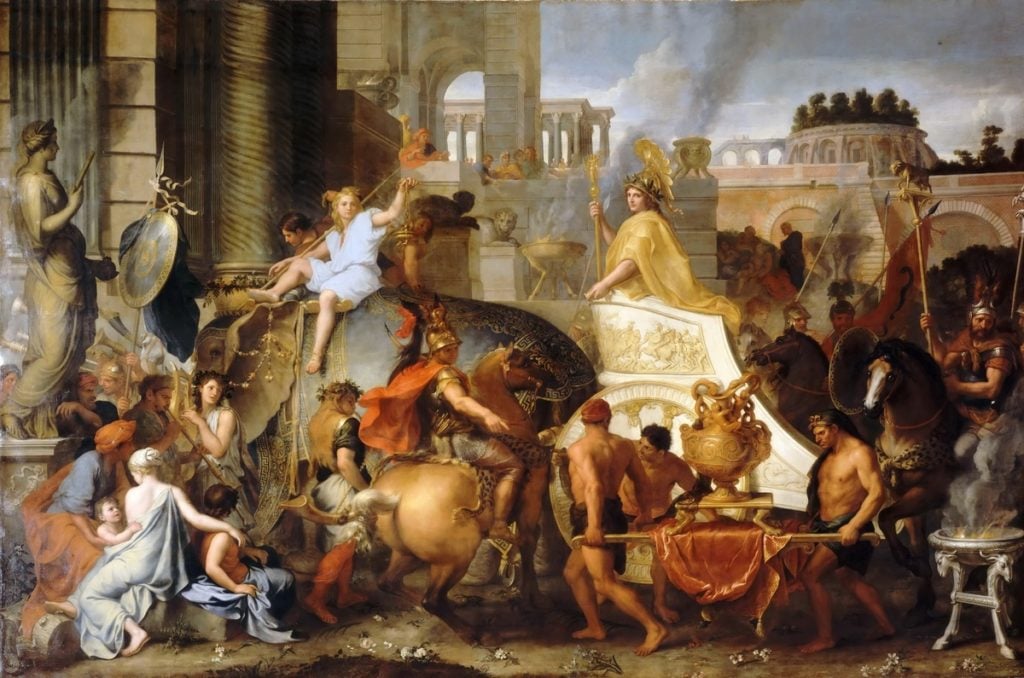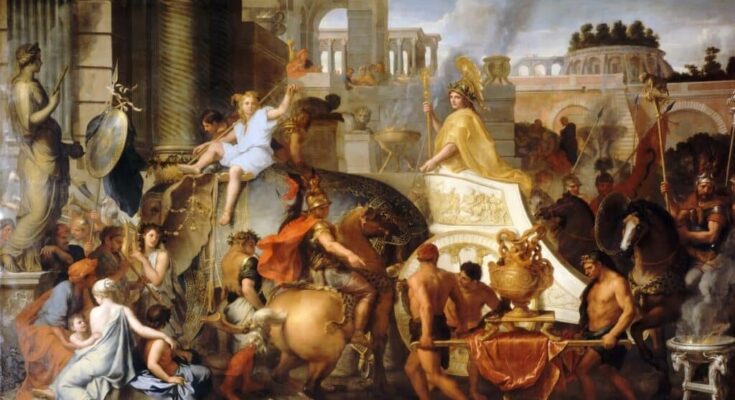
The glorious entrance of Alexander the Great in Babylon as conqueror and savior was the culmination of his great achievements. Ironically, the cherished Babylon was also the place where he drew his final breath.
After his victorious battle in Gaugamela against the Persians, Alexander marched his troops triumphantly into Babylon, famous for its beautiful gardens and tall walls.
The ancient Greek historian, Arrian, wrote: “When Alexander started from Arbela, he advanced straight towards Babylon; and when he was now not far from that city, he drew up his army in order of battle and marched forward.”
When he reached the gates of the great city with his army, people opened the gates and greeted him not as a conqueror but as a welcome new king and a savior.
The Babylonians came out to meet him in mass, with their priests and rulers, with their hands full of gifts, offering to surrender their city, citadel, and money.
Entering the city, Alexander the Great commanded the Babylonians to rebuild all the temples which Persian king Xerxes had destroyed, and especially that of Belus, their venerated god.
It was a gesture of a king, not one of a conqueror. It was 331 BC.
Alexander the Great and the First Battles
It took three years for Alexander’s mighty army to defeat the largest army in the world, that of the great Persian Empire. He was prepared to be a victor at the age of eighteen.
In 338 BC, when the young Macedonian prince was eighteen years old, he led the cavalry of the Macedonian army of his father, King Philip II, against the Athens-Thebes alliance in the Battle of Chaeronea.
Alexander proved that he was a capable leader, as his cavalry charge broke through the enemy ranks and secured the victory.
The winning battle against the Greek allies had mainland Greece subdued to the Macedonians. Thereafter, King Philip decided to proceed with his ambitious plan to move on toward the Persian Empire.
However, two years later, soon after the Macedonian army crossed the Hellespont and entered Asia Minor, his father was assassinated.
Alexander was crowned king at the age of twenty and became commander-in-chief of the Macedonian army.
For the young king, the most precious inheritance he received was a well-trained, fearsome army of fifty thousand men, as he wanted to continue his father’s campaign against the Persians.
Philip had organized professional elite fighting forces of infantry, cavalry, javelin throwers, and archers. They were comprised of aristocratic young men who would start training at age seven to become officers at eighteen.
The highest rank was in the Royal Companion Cavalry, the king’s personal squadron, and in the Royal Hypaspists, an elite infantry unit comprised of five hundred men that surrounded the king in battle.
Their weapons were also upgraded. The shorter seven-foot long “dory” (the Greek wooden spear) was replaced by the long eighteen to twenty-two foot long “sarissa,” with an iron tip that could puncture heavy armor and impale charging cavalry horses.
The Asia Campaign
Prior to his Asia campaign, Alexander took over Thessaly and Thrace. However, with the absence of feared King Philip, Thebes revolted against the Macedonians in 335 BC.
It was time for a show of strength from the young king. His army not only beat the Theban army but razed the city and sold the entire population into slavery.
The only house that was spared was that of Alexander’s favorite poet, Pindar, along with the city temples.
In 334 BC, Alexander felt ready to pick up where his father left off. To reinforce his army, he decided to entice the Greeks to join his campaign.
When he asked them for help to invade Persia, the Greeks were eager to send men and ships. The Macedonian-Greek army that was formed was named the Hellenic League.
It was time for Alexander’s brave army of fifty thousand to be tested against the largest and best-trained fighting force in the known world.
It is estimated that King Darius III of Persia had an army of a total of 2.5 million soldiers throughout his vast empire.
The elite regiment of Darius was comprised of the “Immortals,” an elite regiment of ten thousand infantrymen whose numbers never changed. When a man was killed, another rose to take his place.
The Persian cavalry and archers were also legendary, as were the scythe chariots which cut down enemy infantry with their razor-sharp wheel hubs.
Alexander the Great and His Victorious Campaign
In the spring of 334 BC, the Hellenic League led by Alexander the Great crossed the Hellespont to start the ambitious campaign and conquer as many Asian cities that belonged to Darius, the king of Persia.
The Hellenic League fought the first battle against a strong Persian force at Granicus River. The men then marched south along the coast, liberating two Greek cities under Persian rule, Aeolis and Ionia.
Alexander continued to take over Greek cities such as Miletus and Halicarnassus. By 333 BC, he advanced to coastal Perga followed by Gordium in Phrygia, where tradition records his encounter with the Gordian Knot.
Legend has it that the Gordian Knot was a complex knot that tied an oxcart. An oracle said that whoever unties the knot will become the king of all Asia. Instead of laboring to untie it, Alexander simply cut it in half with his sword.
Meanwhile, Darius was advancing with his massive army toward the Hellenic League. The two armies met at Issus and clashed. Alexander’s army won a decisive victory, as Darius fled, leaving his family in the hands of the Macedonian King.
Darius sent a letter to Alexander offering peace. Instead, Alexander refused, demanding unconditional surrender. He reminded Darius of the wrongs that Persia had committed against the Greeks.
Following a long siege and after sacking Tyre, the Hellenic League destroyed the city and sold all women and children into slavery.
Alexander the Great in Egypt
At the end of 332 BC, Alexander advanced to his next conquest, Egypt, where the people welcomed him as a deliverer. Persian satrap of Egypt, Mazaces, surrendered without a fight.
In Memphis, Alexander sacrificed to Apis, the sacred Egyptian bull and was crowned with the traditional double crown of the pharaohs.
Whether it was a diplomatic move or not, the Macedonian conqueror placated the priests of Egypt and encouraged their religion. He then appointed native governors but kept the army under Macedonian command.
He founded the city of Alexandria, a beautiful place between the sea and Lake Mariout, and appointed Dinocrates, a Rhodian architect, to lay out the city plan.
He then visited the oracle of god Amon at Siwah where the priest gave him the salutation of a pharaoh as son of Amon. There, Alexander consulted the god on the success of his expedition but never revealed the reply.
In the summer of 331 BC, he moved with his army across northern Mesopotamia toward the Tigris, where Darius gathered a massive force there to oppose him.
The decisive battle of the war was fought on October 331 BC on the plain of Gaugamela. Alexander’s army thrashed the Persians and pursued them for thirty-five miles to Arbela, but Darius escaped with his Bactrian cavalry.
Alexander the Great’s received in Babylon
By the time he entered Babylon, Alexander had won god-like status. No conqueror in history has been so popular to so many people who believed that he was more than a human being.
He was regarded as the son of at least three supreme gods: the Greek Zeus, the Egyptian Ra, and the Libyan Ammon. People truly believed he was protected by the sun god and he was hailed as an avatar of Vishnu.
The beauty of Babylon was unsurpassed at the time. The Hanging Gardens of Babylon was one of the seven wonders of the ancient world. He heard about them as a teenager and always wanted to see them. Now it was time to enjoy them.
Τhere are different theories about the construction and the place of the gardens. Some experts claim they were rooftops gardens, while others suggest they were inside the walls of the royal palace.
Now Babylon was Alexander’s, but he chose Mazaeus, who surrendered it, as satrap in conjunction with a Macedonian troop commander.
Much like Egypt, he allowed the local priesthood to continue their worship. Susa, the capital of Babylon, surrendered its treasures amounting to fifty thousand gold talents.
Alexander’s views on the empire were changing. He chose a joint ruling people consisting of Greeks and Persians, and this served to augment the misunderstanding that now arose between him and his people.
Restless Spirit
Once established himself in Babylon, the restless spirit he was, Alexander continued his expedition further into East Asia after a few months. He reached India, trying to expand the Empire.
Alexander campaigned eastwards for almost five more years. He conquered several territories and won several battles. Other cities surrendered without a fight and welcomed Alexander.
In the winter of 327 BC, Alexander led a campaign against the Aspasioi of the Kunar Valley, the Guraeans of the Guraeus Valley, and the Assakenoi of the Swat and Buner Valleys.
In battle against the Aspasioi, Alexander was wounded in the shoulder by a dart, but his army eventually succumbed.
Then he faced the Assakenoi who fought for days from the stronghold of Massaga. After winning the battle, the Macedonian conqueror was wounded seriously in the ankle and ordered the slaughter of the whole population.
He then crossed the Hindus and fought an epic battle against king Porus, ruler of Hydaspes.
When the expedition came near the Ganges River, ahead was the Nanda Empire of Magadha, and further east, the Gangaridai Empire of Bengalof the Indian subcontinent.
However, Alexander’s army was exhausted after five years of campaigning, and fearing of facing more large armies and bloody battles, they mutinied at the Hyphasis River (Beas), refusing to march farther east.
Hyphasis in India was the mark of the easternmost extent of Alexander’s conquests. In 326, Alexander and his army went on a long journey back.
Back to Babylon
In the Spring of 323, Alexander was again before the gates of Babylon. Reportedly, some of the city priests warned him not to enter, because the omens relevant were not favorable. Alexander disregarded them.
While in Babylon, Alexander reportedly received embassies from numerous states and peoples (Greece, Italy, Sicily, Illyria, Sardinia, Ethiopia, Africa, Spain, Gaul, Scythia and others.)
It was an exhibition of global power, worthy of the greatest emperor of his time.
The warnings of the priests seemed to have some ground. When he travelled to Ecbatana to retrieve the bulk of the Persian treasure, his closest friend, Hephaestion, died of illness or poisoning.[
The death of his friend devastated Alexander and he ordered the preparation of an expensive funeral pyre in Babylon along with a decree for public mourning. The death of Hephaestion was a brush with mortality.
In June 323 BC, the man who believed he was a semi-god was mortal after all. In June 323 BC, he fell seriously ill after a bout of drinking.
He first came down with a fever and suffered severe pain in his back. He felt as if he was being stabbed with a spear.
Alexander’s painful illness lasted twelve days until he was declared dead, leaving his followers devastated. What eased their grief is that his body showed no signs of decomposition until six days after death.
For many, that was a sign that, indeed, Alexander the Great was not a mere mortal.
The illness that caused his death has not being determined after much speculation by many historians and doctors. There are many theories about his illness.
But not as many as the site of his tomb, a holy grail for historians.
Sources: History.com, Factsanddetails.com, Britannica.com, Livius,org



